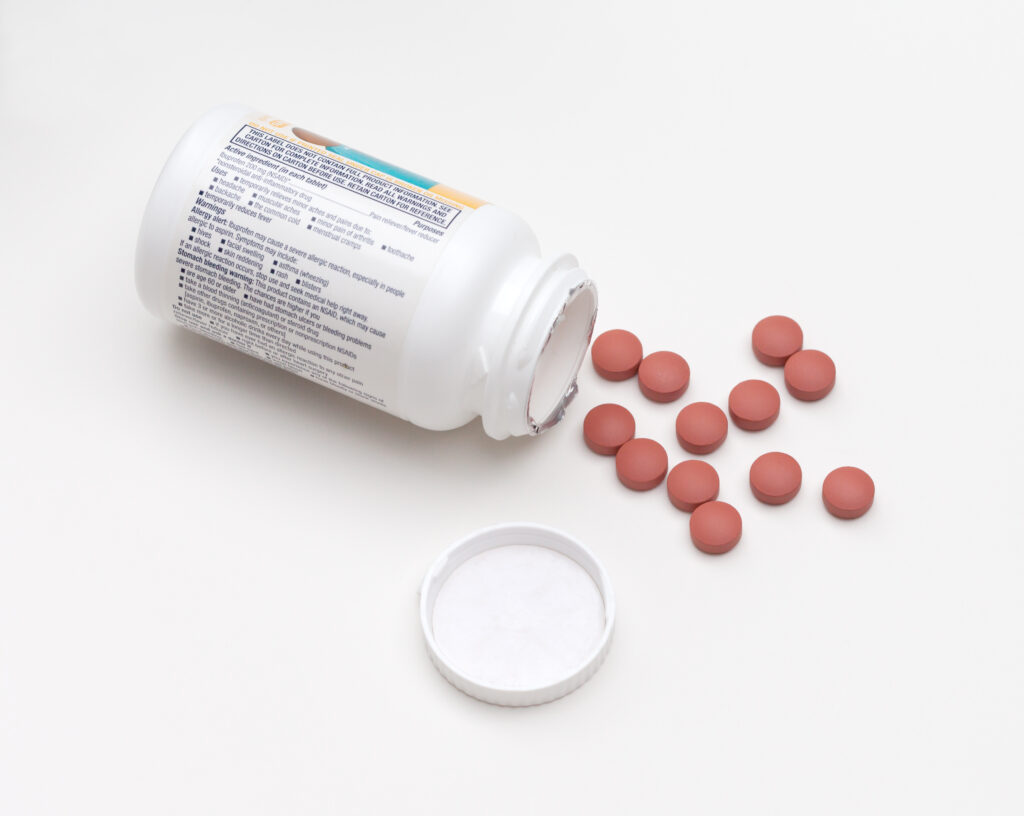
If you experience long-term pain due to inflammation, you’ve likely tried the typical doctor recommendations–heating and icing, soaking in a hot bath, or taking an oral over-the-counter pain killer like ibuprofen (sold as Advil® and Motrin®). But how long is it safe to take ibuprofen?
While taking this drug on a regular basis is effective, ibuprofen can have serious consequences. For this reason, the FDA has issued their highest level of warning (“Black Boxed”) regarding products containing Non-Steroidal Anti-inflammatory Drugs (NSAIDs) such as ibuprofen. One study linked overuse of ibuprofen in arthritis patients to increased gastrointestinal (GI) issues. A more recent study by McGill University shows that blocking inflammation could perpetuate chronic pain.
As more data on the side effects of ibuprofen circulates, it’s important to understand available safe alternatives, such as Capsadyn™. This article explores the negative effects of ibuprofen and how Capsadyn™ provides a safer option for chronic pain.
How does ibuprofen work?
First, let’s take a look at how ibuprofen provides relief. Ibuprofen is an NSAID that works by inhibiting certain enzymes in the body that are responsible for making prostaglandins. Prostaglandins are hormone-like lipids that are made in almost all body tissues and cause inflammation, pain, and fever in the body.
According to Healthdirect.gov:
“Ibuprofen works on one of the chemical pathways for pain. It reduces the ability of your body to make prostaglandins — chemicals that promote pain, inflammation and fever…With fewer prostaglandins in your body, fever eases, and pain and inflammation are reduced.”
Ibuprofen is widely used because it’s easily accessible and effective in reducing prostaglandins. However, prostaglandins are natural to the body and play a significant role in inflammation, which can be protective. Long-term inhibition of prostaglandins can lead to serious side effects.

What are the side effects of ibuprofen?
When patients use ibuprofen on a regular basis, they risk:
- heart complications
- liver complications
- kidney complications
- gastrointestinal (GI) issues
- ulcers
- stomach upset
- high blood pressure
It’s also important to understand how ibuprofen interacts with existing drug use and other health-related conditions. For example, those who are pregnant, on anticoagulants (“blood thinners”) such as warfarin, or have kidney issues should consult with their doctor before use.
Studies suggest risks associated with chronic ibuprofen use
Gastrointestinal (GI) complications
A Stanford University study on the side effects of NSAIDS shows the harmful GI effects:
- Each year, 107,000 patients are hospitalized for NSAID-related GI complications, such as internal bleeding
- Osteoarthritis and rheumatoid arthritis patients are 1.5-5.5 times more likely to be hospitalized for NSAID-related GI events
- The cumulative risk of NSAID-related GI toxicity increases with time
Increased risk of chronic pain
A McGill University study showed additional risks of anti-inflammatory medication. The study suggested that inflammation is an important step in preventing long-term pain. While anti-inflammatory medication reduces immediate pain, preventing this inflammation could actually cause more harm than good over time.
Increased risks for older adults
Other studies show how chronic use of NSAIDs are especially harmful for older adults. Although it is common for older adults to take NSAIDs regularly, they face higher risk for GI bleeds, ulcers, stroke, renal failure, and myocardial infarction. Furthermore, NSAIDs interact with other drugs commonly prescribed to these age groups, such as diuretics, anticoagulants, and corticosteroids.
How to take ibuprofen safely
A “safe” amount of ibuprofen is specific to the patient’s condition. The duration and amount depend on factors like existing conditions, current medications, allergies, age, and weight. Furthermore, everyone metabolizes drugs differently and experiences different effects.
As a general rule of thumb, Cleveland Clinic recommends taking no more than 600 milligrams of ibuprofen 3 times a day, for which use should not continue beyond 3 days.
It’s important that you consult with your doctor on safe usage and take as directed.
Capsadyn™ offers a safe alternative to daily ibuprofen use
Fortunately, there’s now a unique pain relief medication on the over-the-counter market that provides an alternative to NSAIDs such as ibuprofen.
Capsadyn™ is a unique, non-burning capsaicin cream that provides pain relief. Its simple topical application and its general low risk, particular for GI conditions, makes it an attractive alternative to ibuprofen.
What is capsaicin cream?
Capsaicin comes from chili pepper extract. Capsaicin has been known for hundreds of years for its ability to relieve pain. When mixed with body cream to make Capsadyn™, it’s absorbed into the skin, and then desensitizes the nerves that cause pain. Unfortunately, many people find capsaicin creams to produce irritating heat or even burning when applied to the skin.
Due to its proprietary formulation, Capsadyn™ is the only capsaicin cream that blocks pain without skin irritation or burning side effects. Since Capsadyn™ does not produce skin irritation or burning, it can be used at the highest concentration of capsaicin allowed by FDA regulations for over-the-counter capsaicin creams.
While you should experience some relief within an hour of use, many patients report the effectiveness of Capsadyn™ builds up with use over time.
Who should use Capsadyn™?
Unlike ibuprofen, Capsadyn™ is safe for daily use. It’s becoming a popular alternative to NSAIDs, opioids, local anesthetics, steroids, and other pain treatments that carry side effects. (Although rare, interactions of capsaicin creams with other drugs, particularly topical drugs, can potentially occur.)
When used as directed, Capsadyn™ is safe and effective for the treatment of:
- Arthritis
- Simple backache
- Sprains
- Bruises
- Strains
Ready to get back to your regular activity? Give Capsadyn™ a try and get the relief you deserve.
For more information and to order Capsadyn™, visit capsadyn.com.


